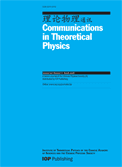
COMMUNICATIONS IN THEORETICAL PHYSICS
Scope & Guideline
Illuminating the pathways of theoretical inquiry.
Introduction
Aims and Scopes
- Quantum Mechanics and Quantum Information:
Research exploring the foundations of quantum mechanics, quantum entanglement, quantum computing, and information theory, including studies on quantum algorithms and protocols. - Gravitational Physics and Cosmology:
Investigations into the nature of gravity, black holes, and cosmological models, with a focus on theoretical frameworks that explain phenomena such as dark matter and dark energy. - Mathematical Physics:
Development and application of mathematical techniques to solve complex problems in physics, including integrable systems, soliton theory, and differential equations. - Statistical Mechanics and Thermodynamics:
Studies addressing the statistical properties of physical systems and their thermodynamic behaviors, including phase transitions and critical phenomena. - Plasma Physics and Nonlinear Dynamics:
Research on the behavior of plasmas, nonlinear wave phenomena, and their applications in various fields, including astrophysics and condensed matter physics. - Field Theory and Particle Physics:
Theoretical explorations of particle interactions, field theories, and their implications for our understanding of fundamental forces and particles.
Trending and Emerging
- Quantum Technologies:
A surge in research focused on quantum technologies, including quantum computing, quantum cryptography, and quantum sensors, indicating a growing interest in practical applications of quantum theory. - Complex Systems and Nonlinear Dynamics:
An increase in studies dealing with complex systems, including nonlinear dynamics, chaos theory, and their applications in various physical contexts, showcasing the evolving understanding of system interactions. - Gravitational Wave Physics:
Research related to gravitational waves and their implications for astrophysics and cosmology has gained momentum, especially following significant observational advancements. - Machine Learning in Theoretical Physics:
The application of machine learning techniques to solve complex problems in theoretical physics is emerging as a prominent theme, indicating the integration of computational methods with traditional theoretical approaches. - Quantum Gravity and String Theory:
A renewed focus on theories of quantum gravity, including string theory and loop quantum gravity, suggests a persistent interest in reconciling general relativity with quantum mechanics.
Declining or Waning
- Classical Mechanics:
While classical mechanics remains foundational, its direct applications in published research have decreased, possibly due to the growing focus on quantum and relativistic phenomena. - Conventional Electrodynamics:
Research specifically centered on classical electrodynamics has become less frequent as interest shifts towards quantum electrodynamics and its implications. - Static Models in Nuclear Physics:
Static models that do not incorporate dynamic interactions or modern computational methods are appearing less often, as researchers seek more comprehensive and dynamic frameworks. - Non-relativistic Quantum Mechanics:
Studies focused solely on non-relativistic quantum mechanics are waning, as contemporary research increasingly integrates relativistic effects and quantum field theories. - Simplistic Models of Dark Matter:
Basic models attempting to explain dark matter without considering complex interactions or new physics are being phased out in favor of more sophisticated and multi-faceted approaches.
Similar Journals
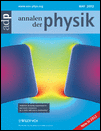
ANNALEN DER PHYSIK
Connecting Scholars Through Groundbreaking ResearchANNALEN DER PHYSIK, a prestigious journal published by WILEY-V C H VERLAG GMBH, stands as a cornerstone of the field of physics and astronomy since its inception in 1799. With an ISSN of 0003-3804 and an E-ISSN of 1521-3889, this journal provides a platform for innovative research and critical discourse across various domains of physics. Annalen der Physik is currently ranked in the Q2 category for general physics and astronomy, occupying rank #76 out of 243 in Scopus, placing it within the 68th percentile. This indicates its significant impact and the quality of research it publishes. Although the journal does not offer Open Access options, its robust historical lineage and ongoing contributions ensure that it continues to be an essential resource for researchers, professionals, and students alike. For those seeking to stay at the forefront of contemporary physics research, ANNALEN DER PHYSIK represents a vital source of knowledge, innovation, and scholarly communication.

Science China-Physics Mechanics & Astronomy
Unlocking the Secrets of the UniverseScience China-Physics Mechanics & Astronomy, published by SCIENCE PRESS, stands as a prestigious journal within the Physics and Astronomy domain, particularly recognized for its contributions to the understanding of fundamental and applied physics. With an exhilarating Q1 ranking in the 2023 category and earning a remarkable scopus rank of #21 out of 243, the journal demonstrates its significant impact, being positioned in the 91st percentile of its field. Operating under an Open Access model, it facilitates the broad dissemination of high-quality research, ensuring accessibility for researchers, professionals, and students worldwide. Its scope covers a variety of essential topics in physics and astronomy, promoting a comprehensive understanding of the latest advancements from 2010 through 2024. The journal is a vital resource for anyone aiming to stay at the forefront of research in these dynamic fields, with its prominent address located in Beijing, China, symbolizing its global influence.
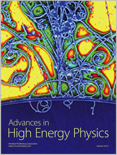
Advances in High Energy Physics
Empowering Discoveries in Nuclear Physics and BeyondAdvances in High Energy Physics, published by HINDAWI LTD, is a premier open-access journal dedicated to the progressive field of Nuclear and High Energy Physics. With an ISSN of 1687-7357 and an E-ISSN of 1687-7365, this journal has been at the forefront of scientific discourse in high energy physics since its inception in 2007. The journal is notable for its impact within the community, currently holding a Q2 ranking in 2023 and positioned at #36 out of 87 in its category according to Scopus, highlighting its significant contribution to ongoing research and advancement in the field. Its accessible nature enables researchers, professionals, and students to engage with cutting-edge findings that shape our understanding of the universe. Spanning publications from 2010 through 2024, Advances in High Energy Physics serves as an invaluable resource for those looking to stay informed about the latest developments and methodologies in high energy physics across the globe.
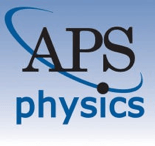
PHYSICAL REVIEW A
Advancing Knowledge in Optics and PhotonicsPHYSICAL REVIEW A, published by the American Physical Society, is a leading journal in the field of Atomic and Molecular Physics and Optics, boasting a Q1 category ranking in its area for 2023. With an ISSN of 2469-9926 and an E-ISSN of 2469-9934, this journal plays a pivotal role in disseminating high-quality research findings, theories, and methodologies that shape current understanding and advancements in the discipline. Although not an open-access journal, it remains highly accessible to professionals and academia through institutional subscriptions. The journal's impactful contributions are evident from its Scopus rank of #70 out of 224 in the field, placing it in the 68th percentile for scholarly impact. As a hub of innovative research and a vital resource for both students and seasoned researchers alike, PHYSICAL REVIEW A remains essential for those seeking to stay abreast of breakthroughs in atomic and molecular studies, as well as optics and photonics.
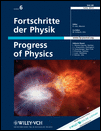
FORTSCHRITTE DER PHYSIK-PROGRESS OF PHYSICS
Advancing the Frontiers of Physics ResearchFORTSCHRITTE DER PHYSIK-PROGRESS OF PHYSICS, published by WILEY-V C H VERLAG GMBH, is a prestigious academic journal esteemed within the field of physics. With a history spanning over seven decades since its inception in 1953 and a converged publication up until 2024, this journal has established itself as a leading source for groundbreaking research and developments across diverse domains in physics and astronomy. Holding an influential Q1 ranking in the 2023 category of Physics and Astronomy (miscellaneous), it serves as an essential platform for disseminating high-quality research findings and theoretical advancements. Although not an Open Access publication, FORTSCHRITTE DER PHYSIK provides access to critical insights and scholarly discussions that are pivotal for researchers, professionals, and students alike. The journal is committed to contributing to the evolution of knowledge in physics, supporting the academic community through rigorous peer-reviewed articles, reviews, and innovative studies.

INTERNATIONAL JOURNAL OF THEORETICAL PHYSICS
Elevating Discourse in Physics and MathematicsInternational Journal of Theoretical Physics is a premier academic journal dedicated to the advancement of knowledge in the fields of theoretical physics and mathematics. Published by Springer/Plenum Publishers, this esteemed journal has been a vital platform for researchers since its inception in 1968. With an impressive track record and an emphasis on high-quality, innovative research, the journal currently ranks in the third quartile (Q3) in both the Mathematics (Miscellaneous) and Physics and Astronomy (Miscellaneous) categories as of 2023. While the journal is not open access, it offers accessible subscription options for institutions and individuals. The International Journal of Theoretical Physics serves as an essential resource for scholars and practitioners looking to deepen their understanding and contribute to the evolving landscape of theoretical research, making it a key player in nurturing academic discourse and fostering collaboration in its field.
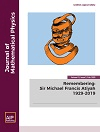
JOURNAL OF MATHEMATICAL PHYSICS
Fostering collaboration in the realm of mathematical inquiry.Welcome to the JOURNAL OF MATHEMATICAL PHYSICS, a distinguished publication dedicated to the burgeoning fields of mathematical physics and statistical and nonlinear physics, published by AIP Publishing. Established in 1960, the journal continually showcases cutting-edge research and theoretical advancements that drive the understanding of complex systems and mathematical formulations within physics. With an impressive Scopus ranking of #38 in Mathematical Physics and #39 in Statistical and Nonlinear Physics, the journal is recognized for its vital contributions to the academic community, achieving a solid Q2 quartile ranking in both categories for 2023. While not an open-access journal, it remains a critical resource for researchers, professionals, and graduate students seeking insights into rigorous mathematical methods and their applications in physical sciences. Engage with the finest research as we converge toward new frontiers from 1960 to 2024, fostering academic collaboration and innovation.
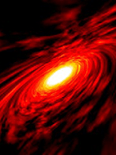
Annual Review of Nuclear and Particle Science
Exploring the Frontiers of High-Energy PhysicsAnnual Review of Nuclear and Particle Science is a prestigious journal published by Annual Reviews, focused on the fields of nuclear and high-energy physics. With an impressive impact factor that reflects its authority and influence—ranked Q1 in its category and holding a commendable Scopus rank of #2 out of 87, placing it in the 98th percentile—the journal serves as an essential resource for researchers, professionals, and advanced students alike. Covering pivotal developments and comprehensive reviews in nuclear and particle physics since its inception in 1978, this journal offers unparalleled insights into cutting-edge research and theoretical advancements. While it is not open access, the value of its scholarly content is evidenced by its rigorous peer-review process and its role in shaping contemporary discourse within the scientific community. With contributions from leading experts and a commitment to disseminating foundational and emerging theories, the Annual Review of Nuclear and Particle Science is indispensable for those seeking a deep understanding of the complexities in these dynamic fields.
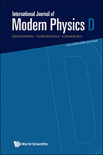
INTERNATIONAL JOURNAL OF MODERN PHYSICS D
Unveiling the Mysteries of the UniverseWelcome to the INTERNATIONAL JOURNAL OF MODERN PHYSICS D, a premier publication dedicated to the advancement of knowledge in the fields of Astronomy and Astrophysics, Mathematical Physics, and Space and Planetary Science. Published by WORLD SCIENTIFIC PUBL CO PTE LTD in Singapore, the journal boasts an impressive impact, being ranked Q2 in Astronomy and Astrophysics and Mathematical Physics, and Q3 in Space and Planetary Science. With a converged publishing timeline from 1996 to 2024, this journal provides a vital platform for researchers and professionals to disseminate their findings, engage with cutting-edge research, and explore emerging ideas in modern physics. Although it operates under a traditional access model, the rigorous peer-reviewed process ensures that only the highest quality research contributes to the collective understanding of our universe. Join us in advancing the frontiers of physics and astronomy!
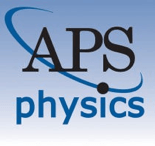
PHYSICAL REVIEW D
Connecting Scholars to the Pulse of Modern PhysicsPHYSICAL REVIEW D, published by the American Physical Society, is a premier journal dedicated to the rapid dissemination of significant research findings in the fields of Nuclear and High Energy Physics as well as Physics and Astronomy. With an impressive Impact Factor and a prestigious Q1 ranking in 2023, it stands as one of the leading journals in its domain, with a Scopus ranking of #6 out of 87 in its category, placing it in the 93rd percentile. The journal welcomes rigorous theoretical and experimental studies that advance understandings in particle physics, cosmology, and quantum field theory. Although it does not provide open access, researchers gain a significant platform to reach a global audience and contribute to the ongoing discourse within the scientific community. Published regularly since its convergence starting in 1989, it remains essential for both emerging and established scholars looking to stay at the forefront of high-energy and nuclear physics research.